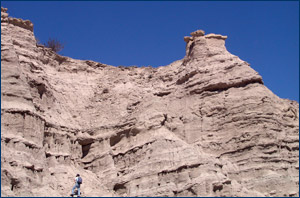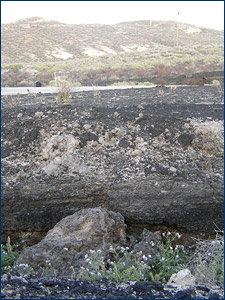
Susumu Tomiya takes a closer look at the rocks of the Ricardo Formation in Red Rock Canyon State Park. Click on any photo on this page to see an enlargement.
Exploring California's fossil history
by Sarah Werning
 Susumu Tomiya takes a closer look at the rocks of the Ricardo Formation in Red Rock Canyon State Park. Click on any photo on this page to see an enlargement. |
Learning more about California fossils and understanding the rocks in which we find them were the goals this past Spring break, when eight UCMPers visited some of the most famous fossil localities in Southern California. Our group consisted of Professor Jere Lipps, his postdoc Zhaoxia Cui, graduate students Katie Brakora, Emily Lindsey, Jenny McGuire, Susumu Tomiya, and Sarah Werning, and UCMP volunteer Antonio Iannarone. Collecting vertebrate fossils requires a permit on public lands, especially in state and federal parks; but on our trip, we focused on the geology, stratigraphy, and paleoenvironments of the fossil deposits. Sort of a paleontological sight-seeing expedition!
The first day, our goal was to make it to Miocene (5.5–23 million-year-old) deposits east of Bakersfield, CA. The Miocene deposits of the San Joaquin Valley represent a time before the Sierra Nevada Mountains were uplifted, when most of the area was under water. As a result, most of the localities preserve marine or near-shore environments. We pulled into camp at Red Rock Canyon State Park late at night, and spent the next morning studying the badlands of the Ricardo Formation (late Miocene) behind our campsite. We only saw one complete fossil bone (a horse's ankle bone), but small scraps of fossil mammal and turtle bone were everywhere.
Next, we headed to Barstow and the Rainbow Basin Natural Area. There are literally hundreds of fossil sites in this area, and we easily could have spent our whole week there. We saw some fossil camel tracks and got some great lessons in how rocks become deformed as a result of local geological activity. We also encountered the endangered California gopher tortoise. We have 20,000-year-old fossils of this species in the UCMP collection; it was great to see a live one. We visited two lakes that have been dry for quite a long time: the Calico Lakebeds (Miocene) and Lake Manix (Pleistocene, over 15,000 years old). At the Calico lakebeds, we collected insects preserved in concretions of rock that will need to be dissolved in acid in order to retrieve the fossils within. Lake Manix records a different time; it was once an enormous freshwater lake in what's now the Mojave Desert and is rich in fossil mollusks, crustaceans, mammals, and birds.
Our next stop was the Salton Sea — the only body of water we visited that is still wet today. It's an interesting place — an unnatural lake in a natural lakebed. For thousands of years, the Earth's crust has been stretched in this area, causing the crust to get thinner and thinner and the ground to sink. Lakes have filled the lowest areas on-and-off when the Colorado River overspilled, but it had been dry for at least several hundred years before last filling in 1905. The Colorado was diverted accidentally when a levee broke, and it took over two years to stop the flow. Agricultural runoff keeps the area wet today, and as a result, the water is extremely salty. Jere and Zhaoxia sampled for living foraminiferans, in order to see if the rise in salinity has led to a change in the species living there.
 Sandy tar deposits at the McKittrick tar seeps in Kern County. |
We then visited the most famous fossil site in California — the Rancho La Brea tar pits (‹40,000 years old) on Wilshire Blvd.'s Miracle Mile in Los Angeles. Many people don't realize how extensive the UCMP's La Brea collections are. We have thousands of specimens from this site at UCMP, including some fantastic examples of the saber-toothed cat Smilodon (the state fossil of California), collected between 1906 and 1917 by J.C. Merriam.
On our drive home, we stopped in McKittrick for one last fossil stop. The McKittrick tar seeps are a little younger (~20,000 years old) and a lot less famous than the La Brea tar pits. There are no pits of liquid tar at McKittrick, but enough tar seeps out of the ground that insects, plants, and animals do get trapped and preserved. We found a lot of insect parts in these sandy tar deposits.
As the sun set on McKittrick, we headed back to Berkeley. Everyone agreed that it was a great trip, and we all learned a lot about the geology and paleontology of California. We're already trying to figure out where to go next year!
Ricardo Formation, wading in the Salton Sea, San Diego Natural History Museum tour, Page Museum tour, and group with ground sloth courtesy of Jere Lipps; Calico Lakebeds by Katie Brakora; Lake Manix, Salton Sea sunset, and Sarah at Anza-Borrego by Jenny McGuire; Jenny on Eocene outcrop by Sarah Werning; McKittrick tar seeps by Susumu Tomiya.